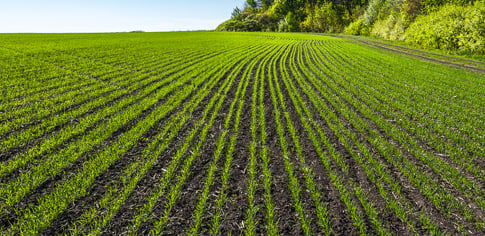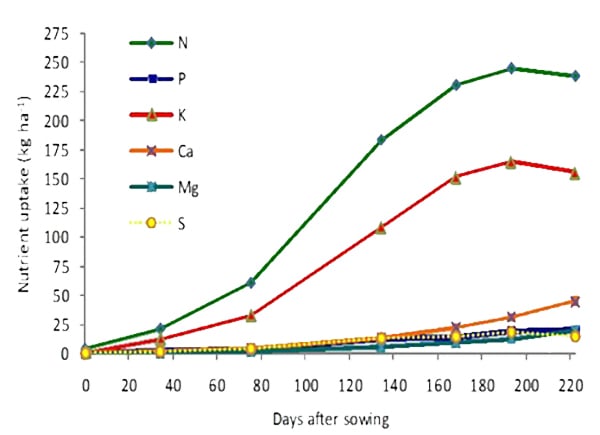Growing Wheat
crop nutrition advice
Everything you need to know about wheat fertilisation, best practice, suitable products, field trials and more.
Advice for growing wheat (Triticum spp.)
-
Rabi crop wheat is widely grown throughout temperate zones (in Europe, Asia and America, up to 60°N), and at higher elevations in some tropical and sub-tropical areas.
-
The majority, more than 4/5th, of India's wheat production comes from northern and central parts of India such as Haryana, Punjab, Rajasthan, Madhya Pradesh, and Uttar Pradesh. Wheat is also produced in pockets of Bihar, Gujarat, and Maharashtra.
-
Yields of most wheat cultivars can be markedly reduced if soil pH is below 5.5, mainly due to susceptibility to P, Mo and Ca deficiencies.
-
The optimal pH for winter wheat is 6.5. In pH greater than 7.5 deficiencies of B, Cu, Fe, Mn, P, and Zn are likely to appear. Wheat can be grown on practically all soil types, except on very light sandy soils, or on peaty soil.
-
The most favourable temperature for flowering, grain initiation, grain formation, and crop maturation is 20-25°C.
-
Wheat is a typical long day crop, meaning most varieties flower earlier when exposed to longer days.

Healthy winter wheat at growing stage

Ripening ears of wheat
Nutrient requirements
Estimated nutrient uptake (kg/ha):
| Variety | Yield t/ha | N kg/ha | P2O5 kg/ha | K2O kg/ha |
|---|---|---|---|---|
| Winter wheat | Biomass* (DM): 13.7 | 187 | 55 | 252 |
| Grains: 6.7 | 130 | 39 | 51 | |
| Spring wheat | Biomass* (DM): 9.0 | 129 | 58 | 125 |
| Grains: 4.5 | 100 | 50 | 25 |
*Whole above-ground part of the plant.
Source: Adapted from Aigner et al., 1988.
Dynamics of nutrient uptake by wheat over a crop season

Reference: Hirzel and Undurraga, 2013
Role of nutrients
| Key parameter | N | P2O5 | K2O | MgO | CaO | SO3 |
|---|---|---|---|---|---|---|
| Yield | +++ | + | ++ | + | + | + |
| Protein content | +++ | + | ++ | + | +++ | |
| Vegetative growth | +++ | + | + | ++ | + | + |
| Root system | + | +++ | + | ++ |
+ = improving
– = decreasing
+/- = different results, depending on the rate of nutrient applied
Source: IPI bulletin – Cereals
Source: Winter wheat – Crop advice sheet (Agronomy Campus)
Nutrient deficiencies
| Nutrient | Description | |
|---|---|---|
| Nitrogen | Plants are pale green to yellow with chlorosis beginning on lower leaves and progressing upwards as the deficiency intensifies; plants have spindly stems and growth is slow. | |
| Phosphorous | P deficient plants may remain darker green than normal plants and develop purple discolouration first on the underside and later throughout. Leaf tips may die back when P deficiency is severe. Plants grow slowly, stems are thin and shortened and maturity is delayed. P deficient plants also exhibit poor tillering. | |
| Potassium | K deficiency initially manifests as chlorosis on the older leaves and progresses upwards as the deficiency intensifies. The leaves eventually become streaked and take on a scorched appearance along the leaf margins. Chlorotic areas may develop throughout the leaf. Deficiency symptoms can occur in young leaves of some fast-maturing high-yielding varieties. Stems of deficient plants are weak and tend to lodge. | |
| Sulphur | Symptoms are similar to nitrogen deficiency, but the chlorosis is uniform and general throughout the entire plant, including younger leaves. Sulphur deficiency is most likely on sandy, free-draining soil and soils low in organic matter. | |
| Calcium | Ca deficiency is very rare in wheat. Plants are severely stunted, and new leaves exude a gelatinous-like material, causing new leaves to stick together. Because Ca deficiency is favoured by low pH (<5.2) and low soil Ca, aluminium- and manganese-toxicity symptoms will usually be exhibited before Ca deficiency symptoms. | |
| Magnesium | Typically, Mg deficiency is found on soils with a pH of less than about 5.2. Wheat is also unable to absorb adequate Mg during cool, wet springs. | |
| Zinc | Zinc deficiency in cereals generally shows up in early growth stages, when plants are only ~10 cm high, appearing first as yellow streaks in the young leaves, with a white to yellowish tip. White spots often appear on the leaves, or along their edges, and a portion of the marginal area may die. Frequently, the entire plant is stunted. | |
| Boron | Terminal shoots die, leaves die back from tips, and young leaves remain rolled (Similar to calcium deficiency). Boron-deficient plants produce very thin ears with a much-reduced grain yield. | |
| Copper | Copper deficiency tends to appear in the youngest leaves as leaf twisting and white leaf tipping, and can result in severe yield reduction. Copper deficiency may be due to low soil availability, or low total soil copper, and is problematic on light, acidic soils, where there is low soil organic matter, granite parent materials, or dry soil. | |
| Iron | Iron deficiency starts as an interveinal chlorosis of the youngest leaves, evolves into an overall chlorosis, and ends as a die-back of the chlorotic leaves. | |
| Manganese | In the early stages, manganese deficiency presents as light chlorosis which appears on young leaves. In more severe cases, mature leaves show netted veins, and then leaves develop brown-grey necrosis along the veins. The chlorotic fleck pattern is concentrated mainly at the leaf base. |
Source: https://vikaspedia.in
The influence of nutrients for wheat resistance
| Disease | Pathogen | Increase resistance | Decrease resistance |
|---|---|---|---|
| Roots: | |||
| Take-all disease | Gaeumannomyces graminis var. tritici | N-NH4, Mn, Cu, Cl | N-NO3 |
| Fusariosis | Fusarium ssp. | Zn, Cl | K |
| Leaves: | |||
| Powdery mildew of cereales | Erysiphe graminis | K, S, Mn | N, Zn |
| Black stem rust | Puccinia graminis | K, S | |
| Brown rust | Puccinia recondite f. sp. Tritici | K, Mn, Cl | Cu |
| Septoria | Septoria tritici | K, Cl | P |
Source: Datnoff L., Elmer W., Huber D., 2007: Mineral nutrition and plant disease, ASP Press, St. Paul, USA, 278 s.
Q&A
Here are some frequently asked questions we received from farmers regarding wheat.
-
To achieve the best yield we must supply the correct nutrients at the right quantity and time. Soil analysis can help to prevent any deficiencies.
-
The protein content is linked to nitrogen availability. The plant must have nitrogen available at the stem elongation stage.
-
To improve the profitability of wheat crops it is important to use efficient nutrition and avoid the application of excess elements (soil analysis can help), and ensure fertilisation takes place at the right growth stages. Controlled Release Fertilizers are the main method to achieve this.
-
Yes, it can be useful, in particular in situations with low soil organic matter (OM). But you must include the organic matter elements in the fertilisation program calculation to prevent excess nutrient application (especially nitrogen).
-
It is possible to achieve a high wheat yield without potassium fertilization in some areas where there is a high content of potassium in the soil. It is important to consider that wheat is grown in a rotation and K is applied to other crops.
Related Crops
Explore other crops



